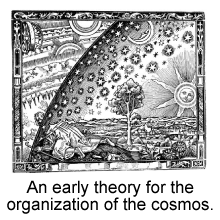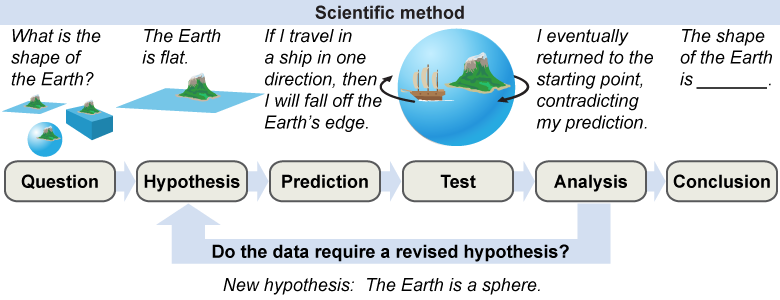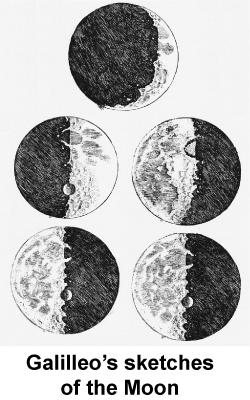|
Scientific research is the process by which multiple, independent people continuously test scientific theories by making new observations. One purpose of research is to find new phenomena that existing theories fail to correctly explain. Unexplained phenomena are often found in new areas of science, such as cosmology or quantum mechanics. Unexplained phenomena are also found when new technologies, such as particle accelerators, make different kinds of observations possible that could not be made before. Science grows as new observations lead to new hypotheses that augment or change existing scientific theories. 
 |
 We were not born knowing the laws of nature, nor was anyone else, including Isaac Newton, Marie Curie, or Albert Einstein. Over a few thousand years, great thinkers such as Aristotle thought about the world and devised hypotheses, or explanations, for what they saw. Those early hypotheses were the necessary starting points for testing and continued thinking that eventually resulted in the modern explanations in this course! Every theory of physics that we have today has a long ancestry of previous iterations that were revised continuously in response to new and better observations and data from experiments. The explorer in the illustration has reached the edge of the (flat) Earth and is peering under the edge of the celestial sphere, which holds the planets and stars according to the Ptolemaic theory of the universe, as was accepted for 1,600 years. The theory was changed when the invention of the telescope made possible new observations that contradicted Ptolemy's theory and supported Copernicus's heliocentric (Sun-centered) theory.
We were not born knowing the laws of nature, nor was anyone else, including Isaac Newton, Marie Curie, or Albert Einstein. Over a few thousand years, great thinkers such as Aristotle thought about the world and devised hypotheses, or explanations, for what they saw. Those early hypotheses were the necessary starting points for testing and continued thinking that eventually resulted in the modern explanations in this course! Every theory of physics that we have today has a long ancestry of previous iterations that were revised continuously in response to new and better observations and data from experiments. The explorer in the illustration has reached the edge of the (flat) Earth and is peering under the edge of the celestial sphere, which holds the planets and stars according to the Ptolemaic theory of the universe, as was accepted for 1,600 years. The theory was changed when the invention of the telescope made possible new observations that contradicted Ptolemy's theory and supported Copernicus's heliocentric (Sun-centered) theory. 
|

 |
Question: the specific issue to be addressed, which is often phrased as a question.
Hypothesis: a proposed answer to the question. A key feature of a hypothesis is that it must be phrased in such a way that it is falsifiable, i.e., that an experiment could be designed that could support or contradict the hypothesis.
Prediction: The hypothesis is used to create a prediction that is often phrased in the form, “If _______, then _______.” In an experiment, the first blank will usually correspond to the independent variable, while the second blank corresponds to the dependent variable.
Test (or experiment): An experiment can be designed to collect new data, or a set of existing data can be identified, to test the prediction.
Analysis: The results of the experimental test are evaluated to determine whether the hypothesis is supported or contradicted. If the hypothesis is contradicted, then a new hypothesis is formed in order to answer the original question.
Conclusion: If the test was successful in providing conclusive evidence in support of the hypothesis, then a conclusion can be drawn from the experiment. 
|
One outcome of research is to produce scientific evidence, such as drawings, measurements, data tables, graphs, or observations. The two most important characteristics of scientific evidence are that it be objective and repeatable. Objectivity means the evidence should describe only what actually happens as exactly as possible, without opinion, interpretation, exaggeration, embellishment, or bias. Reproducibility means that others who repeat the same experiment or make the same observation in the same way always observe the same results. 
|
An experiment is a controlled situation designed to collect scientific evidence on what happens under a controlled set of circumstances. A well-designed experiment changes one variable at a time so that any observed effects may be clearly associated with the variable that was changed. A poorly designed experiment is at best inconclusive, and at worst it supports erroneous conclusions. Experimental evidence should be critiqued by asking the following: - Is the experiment objective? Does it generate unbiased observations?
- Do any observed effects result from changing the variable claimed, or could other variables have caused the effect?
- Do other researchers repeating the experiment observe the same result?
- Have the data been analyzed to understand the uncertainties in measurement?
- Are the observed effects greater than the uncertainties in measurement for this experiment? If not, the experiment may be inconclusive.

Well-designed experiments typically include a control, which is a standard set of conditions that are used for comparison to check or verify a result. For example, when testing the effects of a medicine on a sample of patients, the results might be compared to a control sample of patients who did not receive the medicine. 
 |
 Scientific evidence can come from observing nature without doing an experiment. Nonetheless, the same rules of objectivity and repeatability apply. Astronomy provides a good example since we typically cannot do experiments with stars and planets! Galileo used his telescope to observe the Moon and recorded his observations by sketching what he saw. His sketches describe in detail what he actually saw through the telescope; therefore they pass the test of objectivity. Others who looked through his telescope saw the same thing; therefore the sketches pass the test of repeatability. The scientific evidence of Galileo’s sketches convinced people that the Moon was actually a world like the Earth with mountains and valleys. This was not what people believed prior to Galileo’s time.
Scientific evidence can come from observing nature without doing an experiment. Nonetheless, the same rules of objectivity and repeatability apply. Astronomy provides a good example since we typically cannot do experiments with stars and planets! Galileo used his telescope to observe the Moon and recorded his observations by sketching what he saw. His sketches describe in detail what he actually saw through the telescope; therefore they pass the test of objectivity. Others who looked through his telescope saw the same thing; therefore the sketches pass the test of repeatability. The scientific evidence of Galileo’s sketches convinced people that the Moon was actually a world like the Earth with mountains and valleys. This was not what people believed prior to Galileo’s time. 
|
Clark steps outside on a winter North Dakota morning and throws a rock into the lake outside his tent. He sees that the rock does not sink. Clark forms a hypothesis about the behavior of rocks and water: The colder water is, the slower a rock will sink. Design an experiment to test this hypothesis. Predict whether this experiment will prove or disprove Clark’s hypothesis. If it would be disproved, what would be the revised hypothesis?
 |
An experiment to test this hypothesis would be to get samples of water at a range of temperatures and place an identical rock in each one. The rocks would sink at the same rate in all the samples except for the ones below 0°C (32°F), where they would not sink at all. Because only two sinking rates were observed, sinking and not sinking, Clark’s hypothesis indicating a continuous relationship would be disproved, prompting the creation of a revised hypothesis such as Below 0°C, rocks do not sink in water. Further investigation would lead to the discovery that water becomes a solid below 0°C and that Clark threw his rock into a lake covered in solid water, or ice. 
| |
| |
|

